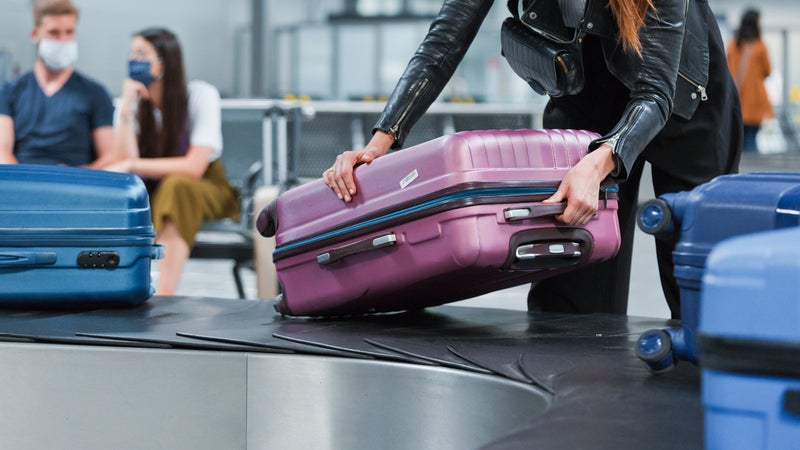What is travel hacking and how do I start?

The Bankrate promise
At Bankrate we strive to help you make smarter financial decisions. While we adhere to strict , this post may contain references to products from our partners. Here's an explanation for . The content on this page is accurate as of the posting date; however, some of the offers mentioned may have expired. Terms apply to the offers listed on this page. Any opinions, analyses, reviews or recommendations expressed in this article are those of the author’s alone, and have not been reviewed, approved or otherwise endorsed by any card issuer.
Key takeaways
- Travel hacking can help you score free or discounted flights, hotel stays and more by strategically using rewards earned from credit cards.
- To get started, set a travel goal for yourself and investigate various airline rewards programs. You'll then want to choose a travel credit card based on factors like your credit score, interest rates and the ability to transfer rewards to partner programs.
- Using shopping portals and dining rewards programs is another way to score extra points, along with taking advantage of card-linked offers from programs like Amex Offers and Chase Offers.
- Stay on top of "mistake fares" by signing up for notifications from airfare deal sites, and consider booking travel during award sales or off-peak travel seasons.
Over the last decade, travel hacking has become a mainstream phenomenon. That’s largely thanks to social media, with influencers showing off exotic destinations on Instagram, reached through the clever use of rewards.
And the appeal is widespread. Families can significantly bring down the cost of a Disney vacation, while the aspirational crowd can book first-class tickets for pennies on the dollar.
As someone who has been travel hacking for over a decade, I’ve seen and done it all. It’s a rewarding hobby that can open up a world of travel opportunities. By hacking flights and hotels, you can save substantially on these expenses.
What is travel hacking?
Travel hacking typically refers to the variety of ways you can earn points and miles toward future travel, often without flying or staying at hotels. It involves strategically using credit card points or miles, or those earned with airline and hotel programs, to score discounted (or free) travel and other perks.
How to start travel hacking
If all of that sounds exciting and you’re eager to get going, here are some tips to help you get started:
Set a goal
The first step in your travel hacking journey is to set a travel goal. Earning points without knowing what you’re working toward can be an exercise in futility. When I started back in 2011, I made the mistake of mainly accruing Delta SkyMiles and American AAdvantage miles for a trip to Europe. I learned pretty late that American Airlines had a weak route network to Europe at the time, and that United MileagePlus miles would have been a much better option back then.
Think about where you want to go well before you start focusing on how you’re earning points. Then, research the best rewards programs to get you there. Bankrate’s travel toolkit highlights a variety of credit card, airline and hotel rewards programs to help you make the best choice.
Find the right rewards credit card
The easiest way to boost your points balance is with a rewards credit card. After you sign up and get approved, you can typically earn a welcome bonus of 50,000 or more points after completing a spending requirement over three or more months. While welcome bonuses are a significant draw, you can also take advantage of category bonuses and annual spending bonuses to maximize your everyday spending long-term.
Those ongoing rewards should be an important factor in your travel rewards card decision. Most people will benefit from credit cards that earn transferable rewards like these:
These currencies offer flexibility because you can transfer them to several airlines or hotel programs at a 1:1 ratio. If one transfer airline doesn’t have award space on your desired travel dates, then you can transfer them to one that does. You’ll have options and stay protected against possible program devaluations as well.
Once you have a general sense of which credit cards to apply for, make sure you qualify and prepare to meet any application requirements. Here are a few things to consider:
- Your credit score. As you might expect, the best travel rewards cards require good credit. To incorporate credit cards into your travel hacking strategy, you’ll need a score of at least 700. If you’re still working on it, consider waiting to apply when you have a better chance of approval.
- The application rules. Every bank has its own rules pertaining to credit card approvals. Chase has the infamous 5/24 rule that restricts welcome bonuses if you’ve applied for five or more credit cards in the last 24 months. Amex’s once-per-lifetime restriction means if you’ve earned a welcome bonus for one card, you likely won’t be able to earn the same bonus again. There are many more credit card application rules to be aware of. Knowing them before you hit “apply” improves your chances of being approved for a travel rewards credit card.
- How much you’ll pay. If you struggle with paying your credit cards off every month, travel hacking with credit cards is probably not for you. That’s because the interest rates on these credit cards are generally high and will negate any rewards you earn. If you’re not confident you can pay off your balances, you’re better off skipping these credit cards and using alternate methods to earn points and miles.
Use shopping portals
Shopping portals are the way to go if you want to further maximize your points and miles earnings. Nearly every major loyalty program has a shopping portal you can earn rewards with, whether it’s your card issuer or your airline of choice. You’ll earn at least one extra point per dollar spent, plus the points from your credit card.
You can even more easily ensure you’re earning the most points possible with a shopping portal aggregator like Cashback Monitor. Type the name of an online merchant, and you’ll get a list of shopping portals alongside their earn rates.
Many shopping portals also offer spend-based bonuses around the holidays and right before the school year starts. These can be pretty lucrative and help you reach your travel goals faster.
Sign up for dining rewards
Dining reward programs are similar to shopping portals in that they require minimal effort to earn extra points. You can join one of seven airline and three hotel-affiliated dining programs to earn up to 8 additional points per dollar spent, including:
- Alaska Airlines Mileage Plan Dining
- American Airlines AAdvantage Dining
- Choice Hotels Eat & Earn
- Delta SkyMiles Dining
- Hilton Honors Dining
- IHG One Rewards Dine & Earn
- JetBlue TrueBlue Dining
- Spirit Airlines Free Spirit Dining
- Southwest Airlines Rapid Rewards Dining
- United Airlines MileagePlus Dining
These programs can even offer first-dine bonuses and extra points when you write reviews or meet certain spending thresholds every year.
You can join all of these programs, but since they’re all part of the same network, you can’t register the same credit card with more than one program at a time. That shouldn’t be too challenging, even if you only have one credit card. Simply register your card with the program of your choice, earn the first-dine bonus and repeat with the other nine programs until you’ve earned them all. Don’t forget to use a credit card that earns bonus points on dining to maximize your earnings.
Get creative with earning rewards
Once you’ve gotten into the habit of maximizing your everyday purchases, it’s time to get creative. What else can you charge to your credit card while still maintaining a balance that you know you can pay off at the end of the month? I once convinced my boss to let me pay a $35,000 supplier invoice with my credit card. I’ve earned thousands of points on rent and mortgage payments through Plastiq. I’ve also used retail arbitrage to flip dresses worn by Kate Middleton and earn spending requirements.
Think outside the box and you could be well on your way to discovering new ways to boost your points.
What are the best travel hacks?
There are countless travel hacks out there, and the best ones are top secret (for good reason). But if you’re just getting started and want to keep things simple, here are the most valuable hacks to know:
Card sign-up bonuses
Credit card sign-up bonuses are by far the best way to get a lot of points within a short time frame. You may even piece together a luxury vacation by strategically applying for credit cards.
Just make sure you’re aware of any issuer rules that take into account how many cards you’ve applied for in the past. You should also be careful when applying to more than one card in a short time frame. Not only will you need to spend even greater amounts to get more than one bonus, but you can hurt your credit score and make yourself look risky to potential lenders.
Double (and triple) dipping
Double- or triple-dipping is one of the best travel hacks out there. Stacking travel hacking methods can help you earn significantly more miles. For example, let’s say you’re in the middle of a home renovation project — you’ve got expenses, and they’re big. If you can do some shopping online for your project, you can double-dip by earning rewards on your credit card and through an online shopping portal.
If you happen to have an Amex card, you could triple dip by taking advantage of Amex Offers. I’ve managed to do this for large expenses like travel bookings and furniture purchases. Before you buy, think about all the possible ways to earn points and find opportunities to combine them.
Mistake fares
There’s more to travel hacking than just earning and redeeming points. One of my favorite ways to hack travel is through mistake fares. Sometimes airlines mess up and publish fares well below market value. I’m talking about a $450 round-trip business class ticket to Shanghai or a $120 economy class ticket to Abu Dhabi. Over the years, there have been dozens of great mistake fares that travel hackers have taken advantage of.
In most cases, airlines have honored these mistake fares, which has been great for savvy travel hackers who managed to book them. Just know that you may need very flexible travel plans and dates to take advantage. A great way to stay on top of mistake fares is to sign up for alerts with Airfarewatchdog and The Flight Deal. These sites parse the web for amazing deals and share them on social media and their websites when they come around.
Maximizing award redemptions
When you’re ready to book that dream vacation you’ve been saving for, there are three types of awards you should look into: Sweet spots, off-peak award charts and award sales. Sweet spots, in particular, can help you save significantly on award flights.
Many airlines and hotel chains offer peak and off-peak award pricing. By being flexible with your travel dates, you can stretch your hard-earned points further.
How can I travel for free?
Despite what travel influencers like to put into their photo captains, there’s no such thing as free travel. You will almost always pay a fee to earn or redeem points. Whether it’s your credit card annual fee, award flight taxes or resort fees, there will always be costs.
But by leveraging credit cards, points and loyalty programs, you can book incredible travel experiences at a fraction of the cost.
The bottom line
Travel hacking can allow you to travel further and in bigger ways than booking with cash. From hotel, airline and transferable points currencies, you can travel for little to no relative cost by using credit cards to pay for your everyday expenses.
If you’re thinking about opening a travel rewards credit card, keep in mind your travel goals, the card’s sign-up bonus and benefits and how you plan to redeem the rewards you earn. From there, you can try more advanced methods of earning points such as through shopping portals or dining programs.
Don’t forget the responsibility that comes with credit card usage. Travel credit cards have higher interest rates, so be sure to pay your card off in full each month as often as you can.








